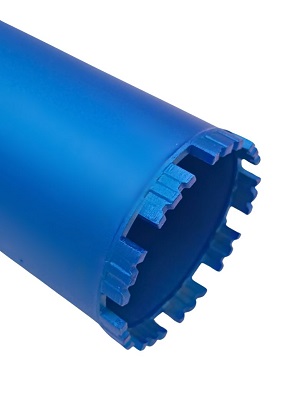How to Choose Diamond (Core) Drill Bits for Concrete and Porcelain – A Practical Guide
Pick the right bit and drilling becomes fast, clean, and predictable. Pick the wrong one and you get chipped tiles, glazed segments, or a cooked motor. This guide walks you through a simple decision flow for concrete (incl. rebar) and porcelain/stone so you can choose the proper diamond core bit, set the right speed, and avoid the classic mistakes.
1) Start with the material
- Concrete / reinforced concrete (RC) – Go for sintered, segmented cores. For heavy rebar, a softer bond exposes diamonds faster and resists glazing.
- Porcelain / ceramic / natural stone – Choose electroplated (vacuum-brazed) or thin-wall segmented bits. They cut cleanly with low pressure and minimal chipping.
2) Diameter, shank and thread
- Pick diameter to match the fitting (anchors, drains, conduits). As a rule, allow +2–4 mm over the object you’re passing through.
- Match the mount: M14 (angle grinders), 1/2" BSP or 1 1/4" UNC (core rigs). A wrong thread means run-out and premature wear.
3) Wet vs dry
- Wet drilling – Best life and speed, essential for concrete coring. Feed a steady (not excessive) water flow to cool and carry swarf.
- Dry drilling – Great for quick holes and mobile work (esp. tiles). Use short pecks and let the tool cool between passes. Respect the maker’s max RPM.
4) RPM and feed (keep it steady)
The bigger the core, the lower the RPM. Small porcelain bits (6–12 mm) can run very fast on M14 tools; large concrete cores (68–132 mm+) need much lower RPM. Apply firm but steady pressure—diamonds must grind, not rub or bounce.
5) Centering and clean starts
- Use a centering ring/guide or begin at a slight angle (~10–15°) and straighten once the rim has “bitten”.
- On glossy porcelain, reduce pressure at the start and consider masking tape to improve grip.
6) Dressing and tool life
- If cutting slows, dress the segment on a dressing stone or soft abrasive (e.g., sand-lime brick) to expose fresh diamonds.
- Don’t push on a glazed rim—heat build-up accelerates wear and can burn the bond.
7) Frequent mistakes to avoid
- Running high RPM on large diameters.
- Continuous dry drilling without cooling breaks.
- Drilling with noticeable run-out (worn adapter/bearing).
- Forcing through rebar with a dull segment—expect chips and burn marks.
8) Quick selection checklist
Material → Diameter → Mount (M14 / 1/2" BSP / 1 1/4" UNC) → Wet/Dry → RPM → Accessories (centering guide, adapter, dust/water management).
9) Shipping & express options
Free delivery in Poland from 200 PLN. In Warsaw and nearby areas we offer same-day express delivery (even within 1–3 hours for urgent jobs). Call us and we’ll get it moving fast.
Need help matching a core to your tool or material? Send a photo/spec and we’ll recommend a bit, RPM range, and cooling method tailored to your job.


